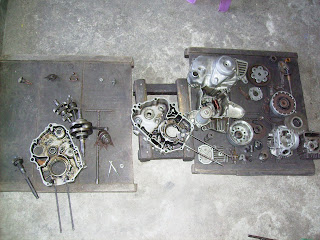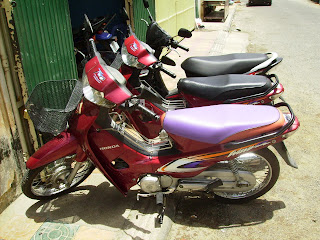Let me start the description of the trip with a picture I took on the way to TC. There is a new Wat being built here, and it added something to an otherwise generic picture of the landscape. As is true of many beautiful aspects of nature, the countryside here is difficult to capture through a lens. I thought that in addition to taking footage of the traffic in Phnom Penh by mounting a camera to my helmet, I could try and capture the grandeur of the Cambodian countryside by documenting a trip to TC in the same manner. Then I realized that this would produce about 90 minutes of footage dominated by me looking at a road. So I’ll work on coming up with a better solution. Maybe mounting the camera on the side of my helmet would be more interesting. But it’s still a lot of footage that would not necessarily illuminate the beauty here.

Maybe part of the beauty I perceive while on the road comes from staring at a road for the majority of the trip, and then looking to the side and thinking “holy skaflnasflnsdvnlodwn this place is amazing.” These trips to SLP and TC are the first time I have travelled for a fairly long time in something not enclosed (car,bus,plane,train) and the experience is, in fact, extremely different. It’s partly due to the fact that things are more tactile. You smell things, bugs hit you and not a windshield, your sense of frailty is heightened by about 1000000 percent as massive trucks speed by you, etc. Nothing made me feel like a piece of the scenery more than almost getting blown over by a bus passing me. The pressure created by the front of the bus pushed me away, but once I got behind that arc of high pressure, I got sucked towards the bus. It was pretty enlivening.
For a more robust and eloquent description of why riding a motorcycle is wholly different from being in a ‘cage’, I would recommend reading some of the excellent books written with motorcycles in mind, namely Zen and the Art of Motorcycle Maintainence by Robert Pirsig and Jupiter's Travels¸by Ted Simon. As a disclaimer, I have not read the second recommendation. Many people have pondered the attraction of motorcycles, though. It’s something that occupies my mind as well I guess.
Let me get back to the point. After arriving at SLP and finding Leb Ke (this is pronounced ky, like sky) he showed me a new place that could potentially be used as the shop. It has already been built, and has accessible water and electricity lines. The rent is not much higher than just renting land, it’s closer to Route 5 than any of the other potential sites, and finally, it’s across the street from the SLP market.

Here you can see the front door of the shop, along the right edge of the picture. At the left edge is the market, where I bought some fruit to give to Leb Krem, the head of TC. Food is cheaper here than in PP, which I guess is to be expected, and my monthly rent would drop by a factor of approximately 5, which is also something I’m looking forward to.
This location seems to be the most accessible of the available locations; it already has a building with available water and electricity access and is only about $20 more per month than a site without a building. Assuming a building would cost $2000, which is a fairly low estimate, it would take 100 months, or 8.3 years, for the building cost to be recouped by the lower price of renting the land.
NON SEQUITER SECTION, aka a totally biased rant against hybrids.
This is basically like the argument against hybrid cars. Yes, they get roughly 1.5 times the mileage of a normal small car in a city (the bonus is very small on the highway, and almost entirely due to lower drag coefficient, not drive train efficiency), but you pay a several thousand dollar premium for that mileage, reducing the economical sense it makes to buy a hybrid.
Also, the environmental impact of constructing a building is obviously higher than renting a pre-existing one, and in this age of everything being as green as possible, this would be the TC shop doing its job to be environmentally responsible.
In the vein of enviro-responsibilty, Hybrids are not as good as people think they are. While they use less gasoline and therefore produce slightly smaller amounts of greenhouse gases, in order to produce the car’s batteries and other assorted electronics all kinds of gnarly heavy metals need to be mined, refined, and crafted into their respective parts. So they loose their ‘green-ness’ there as well.
So please buy a manual Honda Fit, or something similar. Or pretty much any used car, which is better for everyone than buying a new one. Except Detroit. But they are basically toast anyway.
END OF NON SEQUITER SECTION
So I was excited about this new shop option, although the inside is pretty grim. It’s big enough for a small operation, but I’m not sure it will be capable of encompassing living quarters as well, which would be important for preventing theft. Here is the inside of it, with a double or queen size bed to provide a sense of scale. The bed is not quite to the front edge of the room, so it’s a little bigger than this picture makes it look, but still could be accurately described as ‘cozy’.

Leb Ke and I then were off to TC, which was an adventure in and of itself. I had never driven with a passenger, and the road surface was extremely dicey at points. There was one section that was sandy. Sand + inexperienced driver + Two People + Street Tires = Danger. Fortunately we never fell, but it was tense. The dirt bike will be much safer, if it ever gets successfully registered. Still, we made it to TC, and hung out on the porch-y area of the mosque. Meeting Leb Krem and everyone else from TC was good, but we didn’t actually spend that much time talking about the moto project. Leb Ke mostly talked to everyone about how things were going, including the agricultural initiative he has been working on.
It was nice for me to find out how many people were interested in working with me, there were about 6 or 7 people who raised there hands when Leb Ke asked who was interested, and there were others busy working in the fields, so more may end up going through whatever program we set up. They were of more widely varying ages than I expected, from teenagers to guys in approximately their mid-late 30’s.
I tried to show some books I brought, but it didn’t amount to much, which was sort of disappointing. The books were my notebook from school, which has pictures of parts and their phonetic translations, a book of the same type except everything is in Khmer, and the trophy of my collection, Small Gas Engines by Alfred C. Roth. It gives an overview of how all the systems of engines work and how to fix them. It is a textbook that my mom bought me when I was a lawnmower mechanic. I don’t think I realized what an incredibly brilliant gift it was until now. (thanks Mom!) I brought it to school with me, and the teacher from the next stage up came in, and was super amped about it. It turns out one of the engines in the book that they have a lot of pictures of is the engine he uses as a demonstration tool. So that was a cool coincidence.
The trip back from SLP was uneventful, and that about does it for this entry. I’ll wrap things up with a picture of me in front of the mosque, taken by Leb Ke.

I hope everyone’s well.
Ned.










